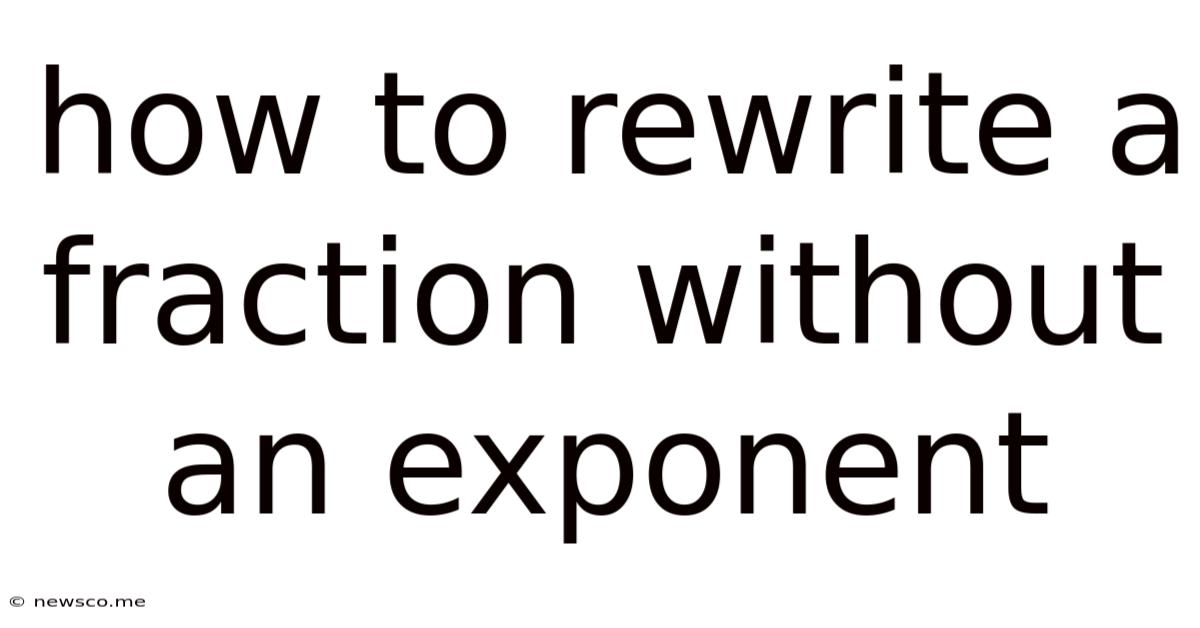How To Rewrite A Fraction Without An Exponent
News Co
May 04, 2025 · 4 min read

Table of Contents
- How To Rewrite A Fraction Without An Exponent
- Table of Contents
- How to Rewrite a Fraction Without an Exponent: A Comprehensive Guide
- Understanding the Basics: Fractions and Exponents
- What is a Fraction?
- What are Exponents?
- Rewriting Fractions with Negative Exponents
- Rewriting Fractions with Fractional Exponents
- Combining Techniques: Complex Fraction Rewriting
- Simplifying Fractions After Removing Exponents
- Practical Applications and Advanced Scenarios
- Troubleshooting Common Mistakes
- Latest Posts
- Related Post
How to Rewrite a Fraction Without an Exponent: A Comprehensive Guide
Rewriting fractions without exponents involves understanding the fundamental principles of fractions and applying appropriate algebraic manipulations. This comprehensive guide will walk you through various scenarios and techniques, equipping you with the knowledge to tackle different types of fractional expressions efficiently. We will cover methods for simplifying fractions, dealing with negative exponents, and transforming expressions with fractional exponents into radical form.
Understanding the Basics: Fractions and Exponents
Before delving into the techniques, let's solidify our understanding of the core concepts:
What is a Fraction?
A fraction represents a part of a whole. It's written in the form a/b, where 'a' is the numerator (the part) and 'b' is the denominator (the whole). The denominator cannot be zero, as division by zero is undefined.
What are Exponents?
Exponents (or indices) indicate repeated multiplication. For example, x³ means x * x * x. Exponents can be positive integers, negative integers, fractions, or even irrational numbers.
Rewriting Fractions with Negative Exponents
Negative exponents indicate reciprocation. Any term raised to a negative exponent can be rewritten as its reciprocal raised to the positive exponent. This is a crucial step in removing exponents from fractions.
Example 1:
Rewrite (x⁻²/y³) without negative exponents.
Solution:
The term x⁻² can be rewritten as 1/x². Therefore, the entire expression becomes:
(1/x²) / y³ = 1 / (x²y³)
Example 2:
Rewrite (2a⁻³b²/c⁻¹) without negative exponents.
Solution:
We rewrite the terms with negative exponents as their reciprocals:
(2 * (1/a³) * b²) / (1/c) = (2b²) / (a³ * (1/c)) = 2b²c / a³
Rewriting Fractions with Fractional Exponents
Fractional exponents represent roots and powers. A fractional exponent m/n means taking the nth root of the base and then raising it to the mth power. This can be expressed using radicals.
Example 3:
Rewrite x^(2/3) without fractional exponents.
Solution:
The fractional exponent 2/3 means the cube root of x squared, which is expressed as:
³√(x²)
Example 4:
Rewrite (4a⁶)^(1/2) without fractional exponents.
Solution:
The fractional exponent 1/2 represents the square root. Therefore, the expression becomes:
√(4a⁶) = 2a³ (Assuming 'a' is non-negative)
Combining Techniques: Complex Fraction Rewriting
More complex scenarios may require a combination of techniques to eliminate exponents.
Example 5:
Rewrite [(x⁻¹y²) / (z⁻³w)]^(1/2) without exponents.
Solution:
First, let's address the negative exponents within the parentheses:
[(y²/x) / (w/z³)]^(1/2) = [(y²z³) / (xw)]^(1/2)
Now, we tackle the fractional exponent (1/2), which means taking the square root:
√[(y²z³) / (xw)]
This can be simplified further depending on the context. If we assume x, y, z, and w are non-negative, we can write:
(y√(yz³)) / √(xw)
Example 6:
Rewrite (16x⁴y⁻²)⁻³/⁴ without negative or fractional exponents.
Solution:
First, we address the negative exponent using the reciprocal:
1 / (16x⁴y⁻²)³/⁴
Next, handle the negative exponent inside the parentheses:
1 / (16x⁴/y²)³/⁴
Then tackle the fractional exponent:
1 / ⁴√(16x⁴/y²)³
This simplifies to:
1 / (2x/y)(⁴√(x⁴/y²)²) = y² / (2x * x²/y) = y³ / (2x³)
Simplifying Fractions After Removing Exponents
Once you've removed the exponents, remember to simplify the resulting fraction. This involves canceling out common factors from the numerator and the denominator.
Example 7:
Rewrite (9x⁶y²/27x³y⁴) and simplify
Solution:
First, simplify the numerical part: 9/27 = 1/3. Then simplify the x terms: x⁶/x³ = x³. Finally, simplify the y terms: y²/y⁴ = 1/y². This gives us:
(x³/3y²)
Practical Applications and Advanced Scenarios
These techniques are fundamental in various areas of mathematics, including:
- Algebra: Simplifying algebraic expressions, solving equations, and manipulating formulas.
- Calculus: Evaluating limits, derivatives, and integrals.
- Physics: Formulating and solving physical problems involving power laws and relationships.
- Engineering: Modeling and analyzing systems involving exponential and power functions.
Advanced scenarios may involve more intricate algebraic manipulations, logarithmic functions, or more complex combinations of exponents and roots. The fundamental principles remain the same, but applying them effectively requires a solid grasp of algebraic techniques and problem-solving skills. Remember to always simplify your answer to its most reduced form.
Troubleshooting Common Mistakes
When rewriting fractions without exponents, some common mistakes include:
- Incorrectly handling negative exponents: Remember that a negative exponent means reciprocal, not a negative value.
- Misinterpreting fractional exponents: Fractional exponents represent roots and powers; don't just remove the fraction.
- Errors in simplification: Always check for common factors to simplify the final answer fully.
- Forgetting order of operations: Remember PEMDAS/BODMAS (Parentheses/Brackets, Exponents/Orders, Multiplication and Division, Addition and Subtraction).
By understanding these techniques and avoiding common pitfalls, you can confidently rewrite fractions without exponents and streamline your mathematical calculations. Practice is key to mastering these concepts – work through various examples, gradually increasing the complexity of the expressions you encounter. With consistent effort, you'll improve your skills and increase your confidence in handling these types of problems.
Latest Posts
Related Post
Thank you for visiting our website which covers about How To Rewrite A Fraction Without An Exponent . We hope the information provided has been useful to you. Feel free to contact us if you have any questions or need further assistance. See you next time and don't miss to bookmark.